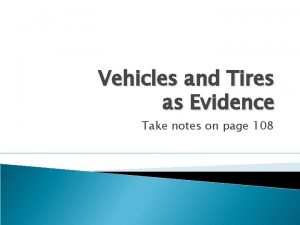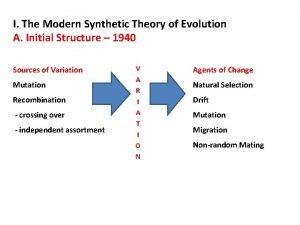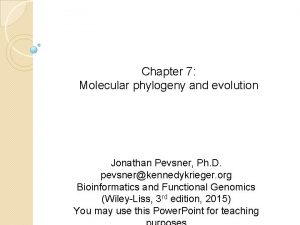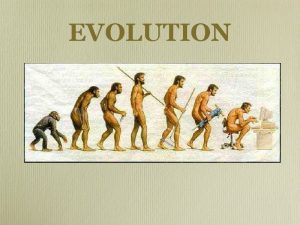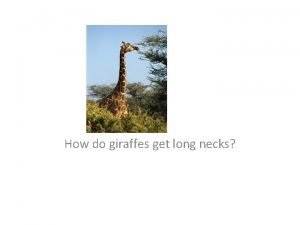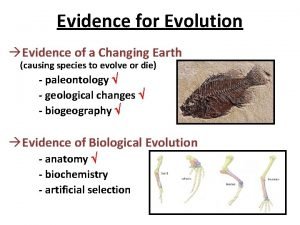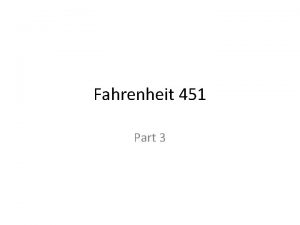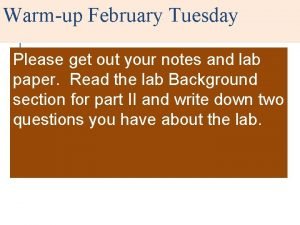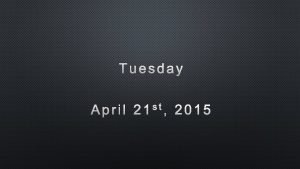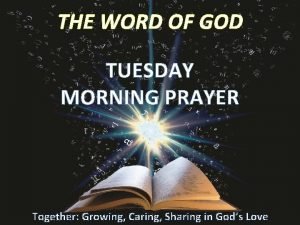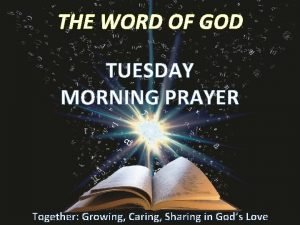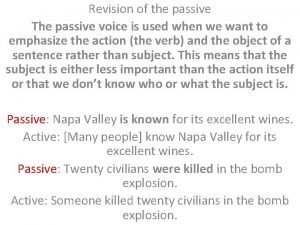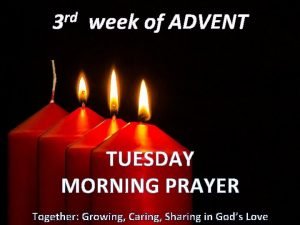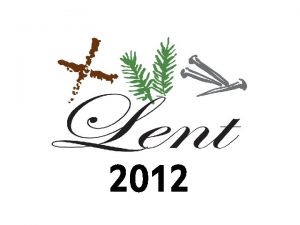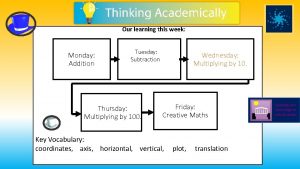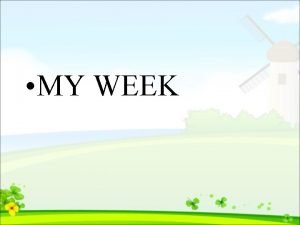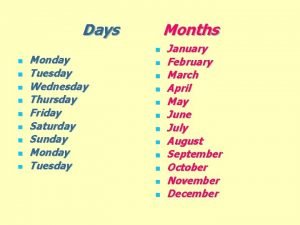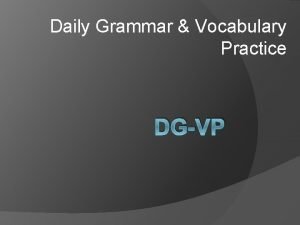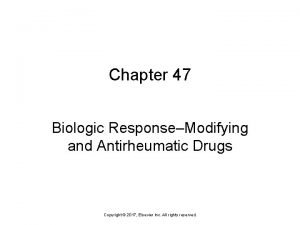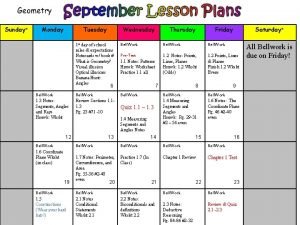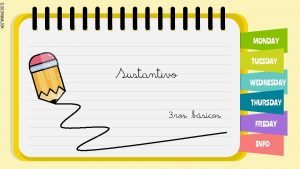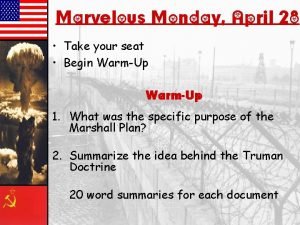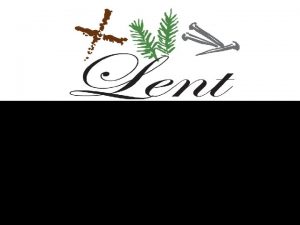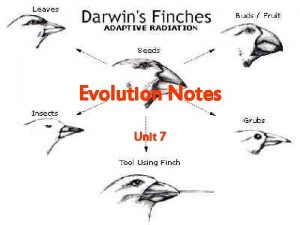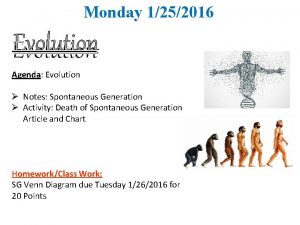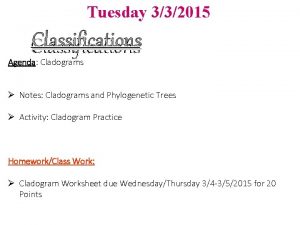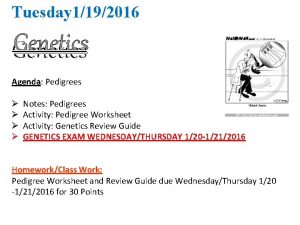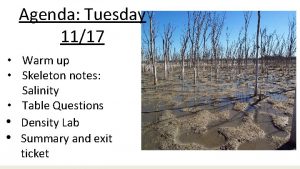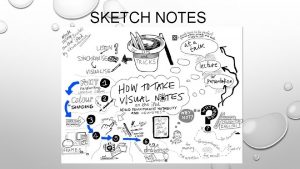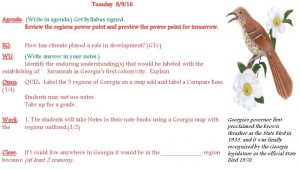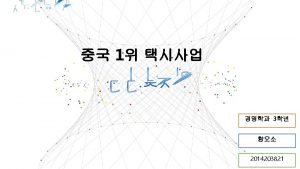Tuesday 2102015 Evolution Agenda Evolution Part II Notes






































- Slides: 38

Tuesday 2/10/2015 Evolution Agenda: Evolution Part II Ø Notes: Rates of Evolution and Radioactive Decay Ø Activity: Modeling Radioactive Decay Homework/Class Work: Radioactive Dating Practice Worksheet due Wednesday/Thursday 2/11 -2/12/2015 for 21 Points

Q 3 WK 4 D 4&5 The Rate of Evolution Different kinds of organisms evolve at different rates Bacteria evolve much faster than complex cells The rate of evolution also differs within the same group of species In punctuated equilibrium, evolution occurs in spurts In gradualism, evolution occurs in a gradual, uniform way

Punctuated equilibrium Gradualism

Draw me GRADULISM PUNCTUATED EQUILIBRIUM

Evidence of Evolution 1. Fossil Records 2. Molecular Records (Carbon Dating and DNA) 3. Anatomical Records

Fossil Records Fossils are the preserved remains, tracks, or traces of once-living organisms Fossils form when organisms become buried in sediment and calcium in hard surfaces mineralizes Arranging fossils according to age often provides evidence of successive evolutionary change Robert Hooke in 1668 - 1 st to propose that fossils are the remains of plants & animals. Provides the most direct evidence for macroevolution

Missing Links Ardi (Ardipithecus ramidus) : stood about 47 inches tall and weighed about 110 pounds. Took 15 years to unearth. Lived 4. 4 million years ago Lucy (Australopithecus afarensis) : 40 % complete skeleton. Lived 3. 2 million years ago

n n Fossils have been found linking all the major groups The forms linking mammals to reptiles are particularly well known Fig. 13. 4 Whale “missing links”

More Missing Links Archaeopteryx. The most primitive known bird. Lived ~150 million years ago. Ambulocetus: The walking whale. This animal could walk as well as swim. It lived ~50 million years ago.

Fossil Records • Relative Dating (aka Law of Superposition) by Nicolaus Steno • By looking at where the fossils are in relation to the rock depth or layers, scientists can see when an organism goes extinct or when there is a mass extinction • In other words, in a cross section of the Earth or rock layers, the lowest layer is the oldest

Molecular Records • Certain atoms are known to decay (break down) at a specific rate. Scientists can look at these atoms to determine how old an organic object is. • Radioactive isotope 14 C- gradually decays over time back to 14 N (known as Carbon Dating) • It takes 5600 years for half of the 14 C present in a sample to be converted to 14 N. • This length of time is called the half-life. • Half life (t 1/2): the time needed for half of the atoms of the isotope to decay • For fossils older than 50, 000 yrs scientists use potassium isotope • t 1/2 of 40 K = 1. 3 billion years to turn to argon (40 Ar)

How do we use the method? Uranium-235 has a half-life of 700 million years. How much of the 12 g sample of Uranium-235 will be left after: • a. 700 million years _______ • b. 1400 million years _______

Modeling Radioactive Decay • Each student needs a textbook; page. 253. • Follow the procedures #1 -8 • Each table will get 1 bag of 100 dried corn kernels & 1 plate / bowl • Each student must complete & turn in a sheet with the completed data table & graph

Radioactive Dating Practice worksheet • Lets practice radioactive dating • Attach into your sci. ntbk

Wednesday/Thursday 2/11 -2/12/2015 Evolution Agenda: Evolution Ø Notes: Anatomical Records and Structures Ø Activity: Structures Foldable Ø Activity: Iceman Murder Mystery Homework/Class Work: Ø No Homework Tonight!

Radioactive Dating Practice Lets practice radioactive dating to better understand the homework: How much of 20. 0 grams of a substance will be left after 1 hour if the half life is 15 minutes (answer in grams) The half life of thorium-27 is 16. 32 days. How many days are required for 2. 63 to remain if you start with 84. 25 grams?

Reading & Organizer Anatomical Record: Informational Text • What is informational text? • What is its purpose? • Why would informational text be vital for science? • Is informational text necessary when discussing evolution?

Anatomical Record n Similar structural forms can be seen in different living organisms 3. Homologous structures Analogous structures Vestigial structures n All vertebrates share a basic set of developmental instructions 1. 2. Relict developmental forms


n Homologous structures: have same structure, DIFFERENT function. However, the structures are derived from the same part of a common ancestor The same basic bones are present in each forelimb Fig. 13. 8 Homology among vertebrate limbs

n Analogous structures: resemble each other as a result of needed adaptations to similar environments (Different animals adapt in similar fashion when challenged by similar opportunities) n The feature has the same function but looks different.

n Vestigial structures: n Although the structure(s) had a purpose & function in the past but they are largely or entirely functionless now. n a vestigial structure may retain lesser functions or develop new ones. The blue whale has tiny hind leg bones under its tail. The blind mole rat has tiny eyes completely covered by a layer of skin.

Friday 2/13/2015 Evolution Agenda: Evolution Ø Notes: Conclusion of Evolution Part II Notes Ø Activity: Evolution Part II Worksheet Homework/Class Work: Ø Evolution Part II Worksheet due Tuesday 2/17/2015 for 20 Points

Anatomical Station Rotation Everyone must complete EACH station Station 1: Homologous Structures- Read Handout, EVERYONE must complete the coloring sheet and Animal / Function chart. Fill out the chart on the BACK of the coloring sheet Station 2: Analogous Structures. EVERYONE completes this on the “Summary Sheet. ” Station 3: Vestigial Structures. EVERYONE completes this on the “Summary Sheet. ” Station 4: Evolution of the Horse. Answer questions on a separate sheet of paper. EVERYONE WRITE & ANSWER Station 5: Vestigial Structures (Part II). Answer questions on a separate sheet of paper. EVERYONE WRITE & ANSWER Station 6: Embryo Evidence. EVERYONE WRITE & ANSWER! Answer questions on BACK of paper you glue embryos on.

Q 3 WK 7 D 1 PATTERNS OF EVOLUTION Coevolution: Change of two or more species in close association with each other. Dependency develops EXAMPLE: Bumblebees and the flowers they pollinate have co-evolved so that both have become dependent on each other for survival.

Convergent Evolution: A kind of evolution where an organism develops structures that have similar (analogous) structures or functions regardless of their evolutionary ancestors being very dissimilar or unrelated. Analogous structures are the result of convergent evolution.

DIVERGENT EVOLUTION: 2 or more related species that become more dissimilar due to different environments. • This usually produces another species EXAMPLE: GALAPAGOS FINCHES

Notebook Check • Warm-Ups: 1/18, 1/22, 1/23 or 1/24, 1/25, 1/28, 1/29 or 1/30, 1/31 or 2/1 • Notes: Rate of Evolution • Activities: Theory Comparison worksheet, 10 Examples of Natural Selection questions, Darwin’s Natural Selection worksheet Worth 27 points

Evolution Part 2 worksheet In your sci. ntbk!


EVOLUTIONARY FORCES n 5 evolutionary forces can significantly alter the allele(s) frequencies of a population n n 1. 2. 3. 4. 5. Mutation Migration Genetic drift Nonrandom mating Selection

Mutation n The MAIN source of new variation Errors in DNA replication and change in DNA due to extraneous factors Mutation rates are too low to significantly alter allele frequencies on their own

Migration n Movement of individuals from one population to another n Immigration: movement INTO a population n Emigration: movement OUT of a population A very potent agent of change

We’re almost done…

Genetic Drift A. Random loss of alleles n More likely to occur in smaller population B. Founder effect n Small group of individuals establishes a population in a new location C. Bottleneck effect n A sudden decrease in population size to natural forces

Mating that occurs more or Nonrandom less frequently than expected by chance n Inbreeding n n n Mating with relatives or self Increases homozygosity Outbreeding n n Mating with nonrelatives Increases heterozygosity Mating

Selection n n Some individuals leave behind more offspring than others Artificial selection n n Creating unnatural characteristics by breeding species to promote a certain type of offspring. Natural selection n Environment selects for adapted characteristics Jack Russell + Mini Italian Greyhound = Guapo

You’re DONE!!! End: Q 3 WK 5 D 2
 Agenda sistemica y agenda institucional
Agenda sistemica y agenda institucional Evidence for evolution doodle notes
Evidence for evolution doodle notes Modern synthetic theory of evolution notes
Modern synthetic theory of evolution notes Neutral theory of molecular evolution notes
Neutral theory of molecular evolution notes Lamarck theory of evolution notes
Lamarck theory of evolution notes 5 evolution and community ecology
5 evolution and community ecology Evolution of shrm notes
Evolution of shrm notes Modern theory of evolution
Modern theory of evolution Lamarckian evolution
Lamarckian evolution Facteur g
Facteur g Fahrenheit 451 chapter 3
Fahrenheit 451 chapter 3 Monday tuesday wednesday thursday friday calendar
Monday tuesday wednesday thursday friday calendar Saturated and unsaturated solutions worksheet
Saturated and unsaturated solutions worksheet Tuesdays with morrie chapters
Tuesdays with morrie chapters Tuesday morning prayers
Tuesday morning prayers Shrove tuesday significato
Shrove tuesday significato Tuesday morning prayer
Tuesday morning prayer Tuesday morning prayer gif
Tuesday morning prayer gif Enduring word matthew 13
Enduring word matthew 13 Stock market crash 1929 political cartoons
Stock market crash 1929 political cartoons Black tuesday political cartoon
Black tuesday political cartoon I want someone to love me into passive voice
I want someone to love me into passive voice Tuesday morning prayer
Tuesday morning prayer Shrove tuesday 2012
Shrove tuesday 2012 Dua for tuesday
Dua for tuesday On monday and tuesday
On monday and tuesday Monday wednesday tuesday thursday
Monday wednesday tuesday thursday Monday tuesday wednesday thursday friday saturday sunday
Monday tuesday wednesday thursday friday saturday sunday My friend jose will travel here on tuesday
My friend jose will travel here on tuesday On a tuesday
On a tuesday Aphorisms in tuesdays with morrie
Aphorisms in tuesdays with morrie Tuesday friends
Tuesday friends Wednesday bell work
Wednesday bell work Monday tuesday
Monday tuesday Marvelous monday terrific tuesday wonderful wednesday
Marvelous monday terrific tuesday wonderful wednesday Tuesday homework
Tuesday homework Thrilling tuesday
Thrilling tuesday Enum week sunday monday
Enum week sunday monday Tuesday bellringer
Tuesday bellringer

